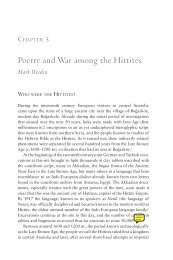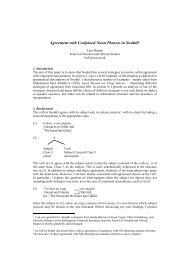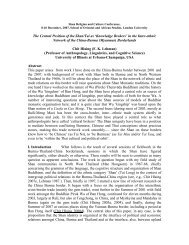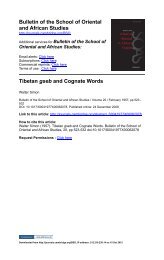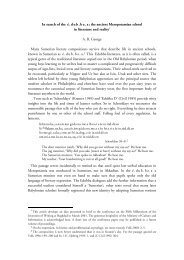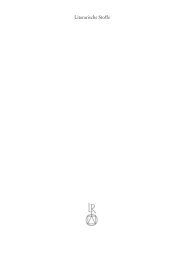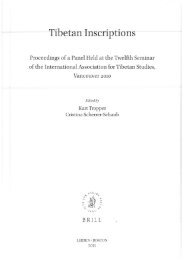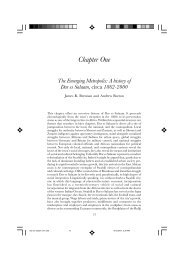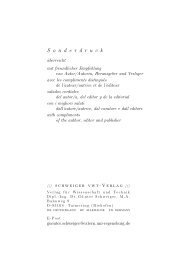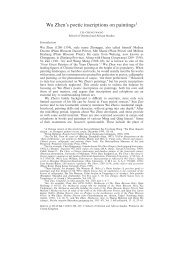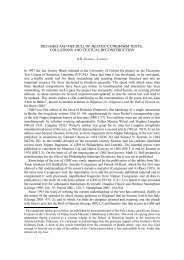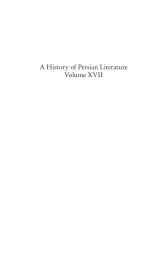000_JLC3_debut_FL - SOAS Research Online
000_JLC3_debut_FL - SOAS Research Online
000_JLC3_debut_FL - SOAS Research Online
Create successful ePaper yourself
Turn your PDF publications into a flip-book with our unique Google optimized e-Paper software.
30 G. Tucker Childs<br />
import semantic structures in this way, speakers of Mani at the least are highly familiar with<br />
Soso; in actual fact today there are no monolingual speakers of Mani. 9<br />
2.4. Sociolinguistic effects<br />
The four following sections exemplify the great variety of observed sociolinguistic effects<br />
of Atlantic-Mande contact.<br />
2.2.5. Language maintenance, diglossia, the Cangin languages<br />
That words are borrowed does not necessarily presage language shift or language death.<br />
Nowhere is this more prominently displayed than in the Wolof-speaking area of Senegal,<br />
where the Cangin languages are found in a relatively small area and have retained their<br />
viability over some time: language maintenance with stable bilingualism. An early report<br />
found that speakers of Cangin languages in Senegal spoke their languages only at home and<br />
were long considered to be speakers of Wolof, a much more widespread and politically<br />
important language (Pichl 1966). A later report, Williams (1994, based on 1986-87 fieldwork)<br />
offered an explanation in speakers’ strong preference for the mother tongue. Similar<br />
observations come from a still later source:<br />
Although there are very few monolinguals among the Cangin groups as a whole,<br />
the languages are still vital. With respect to one, Ndut, the total number of speakers<br />
is 21,<strong>000</strong>, with only 13,<strong>000</strong> of them found in their historical place of origin. Almost<br />
a third are Catholic and the rest Muslim. Most children learn Wolof by the age of<br />
eight, which is the language of instruction in both churches and mosques. There are<br />
few monolinguals, yet Ndut remains the language of the home and intimate<br />
interpersonal relationships (Morgan 1996:1-2).<br />
A more recent assessment (Drolc 2003) characterizes the situation as being one of<br />
prolonged stable bilingualism. The case of the Cangin languages, however, represents an<br />
exception, as will be seen in the following sections.<br />
2.2.6. Restructuring and simplification in Mande languages<br />
Extravagant claims have been made in the historical literature that there has been<br />
restructuring of and language shift to Atlantic languages on the part of the Mande overlords<br />
(Thomas (1919, 1920) as referenced in Rodney (1967:230)). Not enough of the structural<br />
consequences have been presented, and given the historical facts such scenarios are highly<br />
unlikely. The notion that “the Mendes represent the Mane fusion with the Bulloms and the<br />
Kissi, while the Lokos represent the same Mane elements fused with Temne [(Rodney<br />
1967:237] is, in terms of linguistic history at least, jejune and misconceived” (Hair 1968:54).<br />
There were simply not enough speakers of Mande languages to have a structural effect on an<br />
Atlantic language, even including the newly recruited soldiers who spoke a Mande variety<br />
imperfectly as a second language. What is more likely, however, is a change in the various<br />
Mandeng varieties forming part of the later, more militant Mande Expansion. The invading<br />
army needed more soldiers as it advanced and impressed the conquered locals into their ranks.<br />
These second-language speakers likely simplified the variety they learned as part of their<br />
“enlistment”. Bird (1970) has suggested that the homogeneity of the Mandeng languages is<br />
due to the fact that they have undergone simplification in the mouths of second language<br />
speakers (Dwyer 1972; 1975; 2005).<br />
9 No other examples could be identified that were distinct from areal structures which also show up in<br />
resident pidgins (Ross 2007), who faces a similar problem in identifying Takia calquing and<br />
metatypy.<br />
Journal of language contact – THEMA 3 (2010)<br />
www. jlc-journal.org



